-

人教版新目标初中英语八年级下册How long have you been collecting shells教案2篇
Step Ⅱ Show the new words on the screen and teach the new words. Read the new words to students and ask them to repeat.Step Ⅲ 3aThis activity introduces new vocabulary and provides reading practice using the target language.In this activity first look at the four pictures.T: What can you see in the pictures?Ss: Four snow globes.T: Right. There are four snow globes in the pictures. And what are they?Ss: They are a monster, two polar bears, two penguins and a birthday cake.Write these words on the blackboard: snow globe; monster; polar bear; penguin and birthday cake. Read them to the class and ask students to repeat each one. Make sure students understand each word.Use a computer to show the E-mail message on the screen and read the message to students.Get students to read the e-mail on their own, and then draw lines connecting each snow globe and its description.Correct the answers.AnswersA line should connect each snow globe picture with the words that describe it in the letter.Step Ⅳ 3bThis activity provides writing practice using the target language.First review Activity 2a on Page 47.Then ask students to complete the message according to Activity 2a.Some partial sentences are given to students. Write about one person's collection.When students work, walk around the room checking the progress and offering help as needed.When they finish, ask some students to read their messages to the class.

人教版新目标初中英语八年级下册What were you doing when the UFO arrived教案2篇
(一).知识方面: 1.培养学生能运用过去进行时来描述、谈论过去某个时间正在发生的事情或动作的意识和能力,能就过去某个时间正在发生的动作做出正确的描述。 2.培养学生的想象力和角色扮演的合作能力。 3.培养学生讲述过去发生的事情经过的能力。能正确运用一般过去时来讲述故事。 (二).技能方面: 1.本单元的语言目标是Talk about past events and tell a story(谈论过去的时间和讲述一个故事),围绕这一目标,要涉及句型: What were you doing when the UFO arrived? ----I was sitting in the barber’s chair. The barber was cutting my hair. 因此必须学习standing、studying、cleaning、sleeping、cooking、making、eating、cutting、等表示地点的词,以便为上述句型提供语言材料。2.学习过去进行时的有关知识。Was/were+现在分词,是该时态的表达式。 3.在学习过程中,要区分The boy was walking down the street when the UFO landed.和While the boy was walking down the street, the UFO landed.这两种由when和while引导的状语从句的句型结构。注意它们的不同。

人教版新目标初中英语八年级下册Why don’t you get her a scarf教案
教师带领学生复习有关描述宠物的词汇,采用教师提问学生回答的方进行。如:T:What animals do you think would be good pets?What animals do you think would be bad pets?What do you think are good animals for a six-year-old child?然后学生进行 pairwork 练习。Task two: 师生互动,学习探究 1、播放3a部分的录音,引导学生一边听录音,一边跟读。2、通过听录音学生回答以下问题:Why do you think pot-bellied pigs are popular?What are the advantages and disadvantages of keeping such a pet?教师对学生的回答进行及时点评。3.学习范文,学习重点短语,为下步的模仿写作提供语言素材。T :1. )Have you ever kept a pig as a pet?Do you like pigs? St.:No.…Why don’t you like to keep a pig? St: No.They’re too dirty and lazy(Do you know in some foreign countries like Hollyland, Australia,pigs are the most popular pet.there’s a kind of pig.(图)it has an interesting name? it ‘s called a pot-bellied pig.) Now,let’s learn an article about this kind of interesting pet.2.)play the tapeSt.:Listen and repeat3.)show some Qs on computer(本子St.: read silently,then answerthe Qs(本子)4.)Ask ss. Close book and retell this passage.(what is a pot-bellied pig? Is it a good or bad pet? ) St.: retell it to each other“A pot –bellied pig is a popular pet now…”5.read the article together.St.:.practice reading

人教版新目标初中英语八年级下册Would you mind turning down the music教案
Step 4. Group work (4)1. Ask a pair of students to read the dialogue. Say, This activity provides speaking, listening and writing practice using the target language.2. Ask students to complete the work in groups.3. Check the answers with the whole class. 4. Explain some of the language points. Step 5. Word review (Self check 1)1. Ask students to read the words and the phrases given. 2. Fill in the blanks with proper forms of these words to complete the sentences. 3. Check the answers with the whole class. Homework:Do activity 2 on page 57 after class. Period 6Teaching aims: 1. Teach vocabulary words and the useful expressions. 2. Enable the students to learn etiquette in different culture. 3. Help the students learn how to behave politely in public places and in daily life. Teaching procedures:Step 1. RevisionHelp students to review the function of making requests through a free talk. Then lead them to the topic of etiquette. Explain the meaning of etiquette. Or, ask students to look it up in the dictionary. Step 2. Pre-reading (Section 1)1. Ask students to read the picture and make a list with their partner about how many rules of etiquette can be seen being broken.

人教版新目标初中英语九年级下册By the time I got outside, the bus had already left教案
Ⅰ. Teaching Aims and Demands1. Knowledge Objects(1) Key Vocabularyoversleep(2) Target LanguageWhat happened?I overslept. And by the time I got up, my brother had already gotten in the shower.2. Ability Objects(1) Teach the students to use the new words.(2) Train the students to narrate past events with the Past Perfect Tense.(3) Train the students' listening and speaking skills with the target language.3. Moral ObjectIt’s a good habit to go to bed early in the evening and get up early in the morning. So you’ll never be in a hurry in the morning.Ⅱ. Teaching Key Points1. Key Vocabularyoversleep2. Target LanguageNarrate past events with the Past Perfect TenseⅢ. Teaching Difficult Points1. Train the students to narrate past events with the Past Perfect Tense.2. Train the students to understand the target language in spoken conversation.Ⅳ. Teaching Methods1. Thinking of examples from the students' real lives.2. Making sentences by looking at the pictures.Ⅴ. Teaching AidA tape recorderⅥ. Teaching ProceduresStep I Revision1. Revise the language points in Unit 8.Ask some questions like this: What volunteer work would you like to do?Help the students to answer, I’d like to…/I love to…/I hope to2. Practice the dialogue in Activity 3c on page 62 again. Get students to role play the similar dialogues with the following.

人教版新目标初中英语九年级下册Rainy days make me sad教案
1. 教材分析本单元以how do things affect you?为话题, 从颜色、天气、音乐、广告、产品等方面谈论了外界事物如何影响人的心情。要求学生掌握表达某物或某事给人带来的感觉、看法或影响等。共设计了四个部分的内容:Section A 该部分有4个模块:第一模块围绕Which restaurant would you like to go to?这一话题展开思维(1a)、听力(1b)、口语(1c)训练;第二模块围绕How does music affect you? 进行听力(2a-2b)、口语训练(2c);第三模块继续围绕how do colors in the restaurant affect you这一话题展开训练,训练形式为阅读和问题体验(3a)和小组活动(3b);第四模块仍就How do things affect you这一话题以调查的形式展开讨论。Section B该部分有4个模块:第一模块围绕产品广告对人们的影响这一话题以“配对”(1a)与“列举”(1b)两种形式展开训练;第二模块继续围绕How do things affect you? 进行听力(2a-2b)、口语对话训练(2c);第三模块围绕“Advertising”这一话题展开阅读(3a-3b)和写作(3c)训练;第四模块围绕How posters affect you这一话题以口语训练形式展开小组活动。

人教版新目标初中英语九年级下册Could you please tell me where the restrooms are教案
Step Ⅰ RevisionCheck homework. Ask a few students to read the article in 3a.Then ask a few students to read their guides.Step Ⅱ Part 1Look at the words in the box. Ask a student to read them. Make sure the students understand the meaning of the words. You are to fill in the blanks with the words. In some cases, students may need to use another form of the word, for example adjusting for tense or subject/ verb agreement.Ask students to fill in the blanks on their own.Check the answers. Step ⅢPart 2Go through the instructions with the class.Look at the example with the students.Ask students what the answer would be.Ask a student to read the question and answer it.Excuse me, could you tell me where the bank is, please?The bank is across the street from the shopping malt.Get students to complete the work in pairs.Check the answers. Ask a few students to read their questions.Step Ⅳ Just for Fun!Ask all the students to read the conversation. Ask: What is funny about this cartoon? Help students to explain. A Martian is a person from the planet Mars.There is no such thing as Martian food on Earth, and the clerk looks silly because he is trying to think of where there is a Martian restaurant.Invite some pairs of students to present this conversation to the rest of the class.Step Ⅴ Summary and HomeworkIn this class, we’ve done much writing practice using the key vocabulary words and the target language presented in this unit. After class, please finish the questions in 2 in your exercise books. Then finish the exercises on pages 47~48 of the workbook as well.The Seventh Period Ⅰ Teaching Aims and Demands1. Knowledge Objects(1) Key Vocabularyimage, adventure, jealousy, hero, crime, journey, brave, no longer, show interest in, take it easy, become interested in, plain looks(2)Text:Grown-ups like cartoons, too.2. Ability Objects(1) Fast-reading to get a general idea of the text.(2) Careful-reading to get the detailed information in the text.

人教版新目标初中英语九年级下册I’ll help clean up the city parks教案
Talk about offering help (P60)I’ll help clean up the city parks.A: I’d like to work ...B: You could help ...Talk about ways to tell people about the Clean-Up Day (P61)We need to ...We can’t ...I’ll ...Talk about the work the volunteers do (P62)These three students all volunteer their time to help other people.Somebody loves to ... / helps ... / plans to ... / wants to ...A: What do you like doing?B: I like ... A: What kind of volunteer work do you think I could do?B: You could ...1. 重点词汇advertisement, fix, repair, pleasure, blind, deaf, shut, carry, specially, fetch2. 认读词汇hunger, homeless, cheer, clean-up, sign, establish, major, commitment, elementary, veterinarian, coach, similar, call-in, strategy, disabled, organization, unable, support, appreciate, donation, part of speech, pronoun, adverb, preposition, conjunction, donate, Jimmy, Sally3. 词组clean up, cheer up, give out, put off, set up, think up, take after, fix up, give away, put up, hand out, work out, at once

人教版新目标初中英语九年级下册We’re trying to save the manatees教案2篇
本单元主要围绕着有关濒临灭绝的动物这一话题,学习了应该怎样保护我们的环境,以及就某一问题展开辩论。目标提示语言目标能够运用所学知识,就某一问题展开辩论。认知目标1、复习一些语法:现在进行时、一般现在时、用used to 表示一般过去时、现在完成时、一般过去时的被动语态。2、学会表达同意和不同意。3、学会以下基本句型:We’re trying to save the manatees.Manatees eat about 100 pounds of food a day.There used to be a lot of manatees.In 1972,it was discovered that they were endangered.Some of the swamps have become polluted.情感目标了解一些濒临灭绝的动物的生活习性和濒临灭绝的原因,教育学生应该如何保护环境。教学提示充分利用多媒体等教学设备,创设与本课话题相关的情境,如各种不同种类的动物、动物园以及有关环境的画画等等。围绕着本单元的教学目标,设计一些贴近学生实际的教学任务,如让学生谈论自己最喜欢的动物,如何拯救濒危动物,如何保护环境等等。让学生根据所学知识,就动物园是否对动物有利以及其他的话题进行辩论。

人教版新目标初中英语九年级下册You’re supposed to shake hands教案
教学目标:1. 掌握本单元一些重点词汇的写法和用法。2. 学会自如谈论餐桌礼仪。Step 1 RevisionAsk some students to retell the customs at the table in France in the passage in 3a.Step 2 Self checkPart 1. Fill in each bland with the correct word given. Students do the exercises by themselves at first. Then check the answers. Ask the students to comprehend the sentences and help them point out uses of some words, like “arrive (at / in) sw., spend time / money on sth , spend time / money (in) doing sth.”Part 2. Read about Fan Ling’s experience in a western restaurant. Understand the passage. Point out some key points in the passage.1. be / get used to doing sth. 习惯做某事2. begin with = start with 以….开头3. crowd v. 挤满,塞满 the crowd 人群 crowded adj. 拥挤的Then students discuss about how she would solve her problem. Ask some to share their stories with others.Part 3. Complete the crossword by looking at the sentences on the left. Then check the answers.

人教版新目标初中英语八年级下册If you go to the party, you’ll have a great time教案2篇
区分宾语从句、定于从句和状语从句宾语从句和状语从句,都叫做主从复合句。宾语从句主要是中考必考的,是初中阶段必掌握的从句,宾语从句主要是掌握三要素,所谓宾语从句,就是宾语在主从复合句当中充当宾语的一个句子,叫做宾语从句。主句的谓语动词是及物动词,后面如果是词或者是短语的话,是简单句,如果是句子的话,肯定是宾语从句。I know that he good at English.就是宾语从句,三要素,一要素是要注意连词,连词一共学了三类连词,一类连词是that口语当中可以省略,就像刚才说的那一句,I hear he is good at English.还有疑问代词、疑问副词,how where when,疑问代词、疑问副词。还有一类连词weather是否的意思,不是状语从句当中的如果,这一定要和如果区分开,这是是否。I don't know if he interested at English。宾语从句要注意if是连词。第二要素是语序,要用陈述举语序。比如说你家有几口人,我们都说How many people are there in you family?但是这是简单句,一旦说成宾语从句,你可以告诉我你家有几口人吗?Could you tell me how many people there are in you family ?

部编人教版二年级上册《曹冲称象》说课稿
全文共有五个自然段,是按照事情发展的顺序记叙的。第一段写的是曹操带着儿子和官员去看人家送给他的一头大象。第二段写的是这头大象又高又大,官员们议论大象的重量。第三段写的是官员们想出了几种称象的办法,曹操听了直摇头。第四段写的是曹冲想出了称象的办法。第五段写的是人们照曹冲说的办法去做,果然称出了大象的重量。在三、四自然段中,通过官员们与曹冲不同的称象方法的对比,揭示了文章的中心,把一个聪颖、质朴的儿童形象展现在读者面前。第四自然段讲曹冲叙述的称象方法和步骤是本课的教学重点。曹冲的称象方法是用四句话说明的。第一至第四句具体地写出了称象的方法,一句话就是一个步骤。文中通过“赶、沉、画、赶、装、沉、称”这几个动词的连用、准确、清楚地写出了称象过程,使学生理解曹冲以船代秤、以石代象的科学的称象方法。用水的浮力来称象的知识,是本课教学中的难点,教师在教学中要努力使文章中抽象的语言文字具体化,以帮助学生理解曹冲称象的具体方法和步骤。
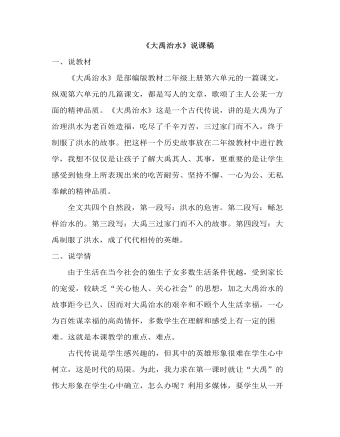
部编人教版二年级上册《大禹治水》说课稿
一、说教材《大禹治水》是部编版教材二年级上册第六单元的一篇课文,纵观第六单元的几篇课文,都是写人的文章,歌颂了主人公某一方面的精神品质。《大禹治水》这是一个古代传说,讲的是大禹为了治理洪水为老百姓造福,吃尽了千辛万苦,三过家门而不入,终于制服了洪水的故事。把这样一个历史故事放在二年级教材中进行教学,我想不仅仅是让孩子了解大禹其人、其事,更重要的是让学生感受到他身上所表现出来的吃苦耐劳、坚持不懈、一心为公、无私奉献的精神品质。全文共四个自然段,第一段写:洪水的危害。第二段写:鲧怎样治水的。第三段写:大禹三过家门而不入的故事。第四段写:大禹制服了洪水,成了代代相传的英雄。
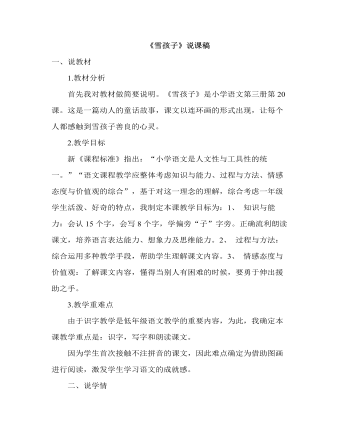
部编人教版二年级上册《雪孩子》说课稿
1.教材分析首先我对教材做简要说明。《雪孩子》是小学语文第三册第20课。这是一篇动人的童话故事,课文以连环画的形式出现,让每个人都感触到雪孩子善良的心灵。2.教学目标新《课程标准》指出:“小学语文是人文性与工具性的统一。”“语文课程教学应整体考虑知识与能力、过程与方法、情感态度与价值观的综合”,基于对这一理念的理解,综合考虑一年级学生活泼、好奇的特点,我制定本课教学目标为:1、 知识与能力:会认15个字,会写8个字,学偏旁“子”字旁。正确流利朗读课文,培养语言表达能力、想象力及思维能力。2、 过程与方法:综合运用多种教学手段,帮助学生理解课文内容。3、 情感态度与价值观:了解课文内容,懂得当别人有困难的时候,要勇于伸出援助之手。
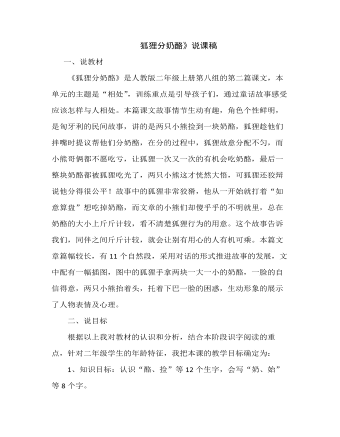
部编人教版二年级上册《狐狸分奶酪》说课稿
二、说目标根据以上我对教材的认识和分析,结合本阶段识字阅读的重点,针对二年级学生的年龄特征,我把本课的教学目标确定为:1、知识目标:认识“酪、捡”等12个生字,会写“奶、始”等8个字。2、语感目标:正确流利有感情地朗读课文,会分角色读课文。3、能力目标:读懂故事内容,能对狐狸的说法作出判断,初步表达自己的想法。三、重难点在确定教学目标后,我把本科划分为两个课时,本次说课的内容为第二课时,其教学重点是理解课文内容、分角色读课文,对狐狸的说法作出判断,初步表达自己的想法。四、说教法、学法。先学后教、以学定教、会的不教。上课前一天下发本课前置小研究,课前检查学生的预习情况,当堂解决孩子们困惑的地方,或者我认为学生需要了解并掌握的知识进行巩固教学,课堂上的教学方法,以小组合作,展示交流为主。
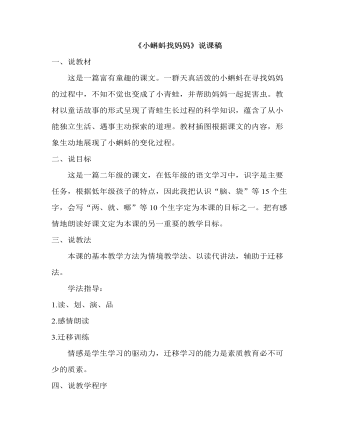
部编人教版二年级上册《小蝌蚪找妈妈》说课稿
一、说教材这是一篇富有童趣的课文。一群天真活泼的小蝌蚪在寻找妈妈的过程中,不知不觉也变成了小青蛙,并帮助妈妈一起捉害虫。教材以童话故事的形式呈现了青蛙生长过程的科学知识,蕴含了从小能独立生活、遇事主动探索的道理。教材插图根据课文的内容,形象生动地展现了小蝌蚪的变化过程。二、说目标这是一篇二年级的课文,在低年级的语文学习中,识字是主要任务,根据低年级孩子的特点,因此我把认识“脑、袋”等15个生字,会写“两、就、哪”等10个生字定为本课的目标之一。把有感情地朗读好课文定为本课的另一重要的教学目标。
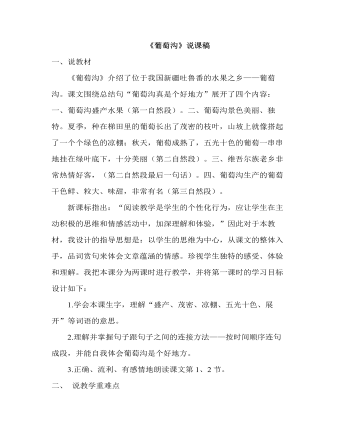
部编人教版二年级上册《葡萄沟》说课稿
三、说教法 :以读为本,读中感悟 阅读教学以读为本,是由阅读教学的基本任务所决定的。阅读教学的基本任务是培养独立阅读的能力和养成良好的阅读习惯,而完成上述基本任务的基本途径是学生自己的读书实践。读可以显形,读可以激趣,可以动情,可以启智,可以育人。因此在本课时的阅读教学中我设计了各种形式的读,让学生充分地读,在读中整体感知,在读中有所感悟,在读中培养语感,在读中受到情感的熏陶,让学生在琅琅书声中益知、怡情,发展语言和能力。四、说学法 :自主学习 合作探究 新课程导引的新课堂,其本质特征在于学生真正成为课堂教学的主体,是实践主体、认识主体,又是道德主体、审美主体。一句话,他们应当是自主发展、自我构建的主体。而活动是主体存在和发展的方式。离开了自主的、具体的、感性的学习活动,学生是无法获得主体地位,也不能发挥主体作用的。因此在本节课的教学设计中,我尽可能地给学生自主学习的机会,自主选择学习内容,自主选择朗读方式,自主选择作业方式,自读自悟,自己观察发现……让学生真正成为学习的主人。
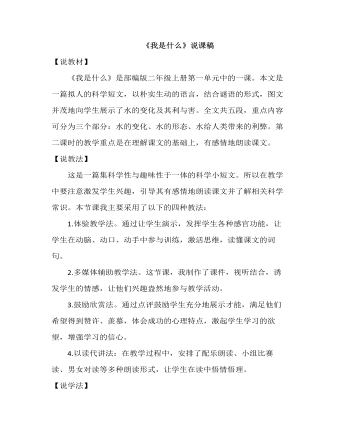
部编人教版二年级上册《我是什么》说课稿
【说教材】《我是什么》是部编版二年级上册第一单元中的一课。本文是一篇拟人的科学短文,以朴实生动的语言,结合谜语的形式,图文并茂地向学生展示了水的变化及其利与害。全文共五段,重点内容可分为三个部分:水的变化、水的形态、水给人类带来的利弊。第二课时的教学重点是在理解课文的基础上,有感情地朗读课文。【说教法】这是一篇集科学性与趣味性于一体的科学小短文。所以在教学中要注意激发学生兴趣,引导其有感情地朗读课文并了解相关科学常识。本节课我主要采用了以下的四种教法:1.体验教学法。通过让学生演示,发挥学生各种感官功能,让学生在动脑、动口、动手中参与训练,激活思维,读懂课文的词句。2.多媒体辅助教学法。这节课,我制作了课件,视听结合,诱发学生的情感,让他们兴趣盎然地参与教学活动。3.鼓励欣赏法。通过点评鼓励学生充分地展示才能,满足他们希望得到赞许、羡慕,体会成功的心理特点,激起学生学习的欲望,增强学习的信心。
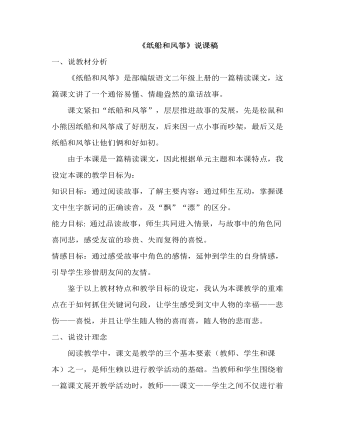
部编人教版二年级上册《纸船和风筝》说课稿
一、说教材分析《纸船和风筝》是部编版语文二年级上册的一篇精读课文,这篇课文讲了一个通俗易懂、情趣盎然的童话故事。课文紧扣“纸船和风筝”,层层推进故事的发展,先是松鼠和小熊因纸船和风筝成了好朋友,后来因一点小事而吵架,最后又是纸船和风筝让他们俩和好如初。由于本课是一篇精读课文,因此根据单元主题和本课特点,我设定本课的教学目标为:知识目标:通过阅读故事,了解主要内容:通过师生互动,掌握课文中生字新词的正确读音,及“飘”“漂”的区分。能力目标: 通过品读故事,师生共同进入情景,与故事中的角色同喜同悲,感受友谊的珍贵、失而复得的喜悦。情感目标:通过感受故事中角色的感情,延伸到学生的自身情感,引导学生珍惜朋友间的友情。鉴于以上教材特点和教学目标的设定,我认为本课教学的重难点在于如何抓住关键词句段,让学生感受到文中人物的幸福——悲伤——喜悦,并且让学生随人物的喜而喜,随人物的悲而悲。
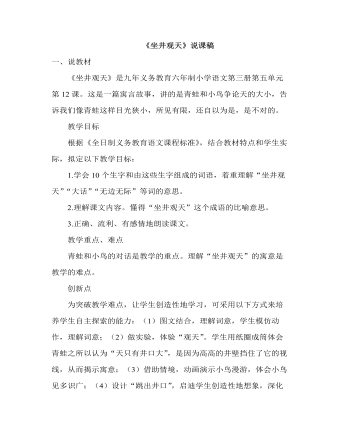
部编人教版二年级上册《坐井观天》说课稿
一、说教材《坐井观天》是九年义务教育六年制小学语文第三册第五单元第12课。这是一篇寓言故事,讲的是青蛙和小鸟争论天的大小,告诉我们像青蛙这样目光狭小,所见有限,还自以为是,是不对的。教学目标根据《全日制义务教育语文课程标准》,结合教材特点和学生实际,拟定以下教学目标:1.学会10个生字和由这些生字组成的词语,着重理解“坐井观天”“大话”“无边无际”等词的意思。2.理解课文内容。懂得“坐井观天”这个成语的比喻意思。3.正确、流利、有感情地朗读课文。教学重点、难点青蛙和小鸟的对话是教学的重点。理解“坐井观天”的寓意是教学的难点。创新点为突破教学难点,让学生创造性地学习,可采用以下方式来培养学生自主探索的能力:(1)图文结合,理解词意,学生模仿动作,理解词意;(2)做实验,体验“观天”。学生用纸圈成筒体会青蛙之所以认为“天只有井口大”,是因为高高的井壁挡住了它的视线,从而揭示寓意;(3)借助情境,动画演示小鸟漫游,体会小鸟见多识广;(4)设计“跳出井口”,启迪学生创造性地想象,深化认识。